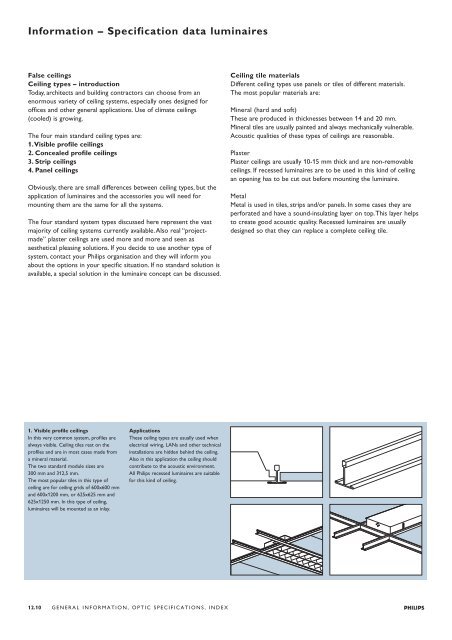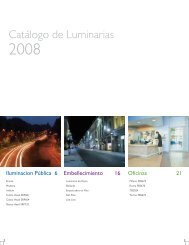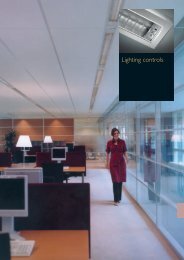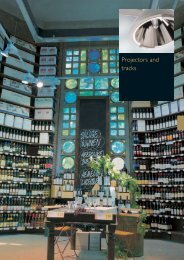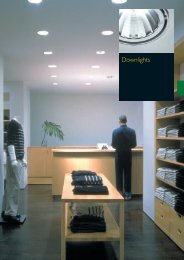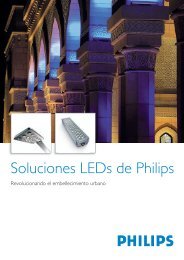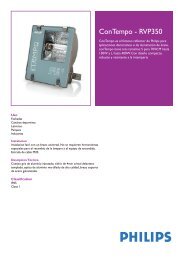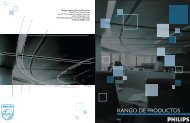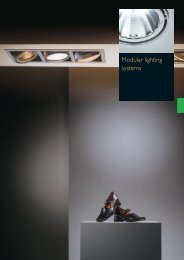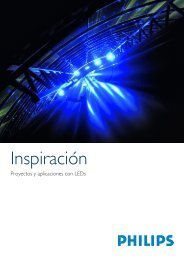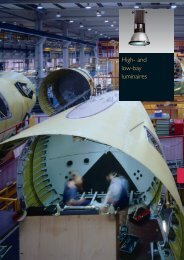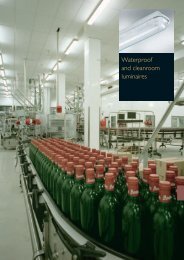General information, optic specifications, index
General information, optic specifications, index
General information, optic specifications, index
You also want an ePaper? Increase the reach of your titles
YUMPU automatically turns print PDFs into web optimized ePapers that Google loves.
L948D949_SRC.QXD 11-03-2004 08:16 Pagina 12.10<br />
Information – Specification data luminaires<br />
False ceilings<br />
Ceiling types – introduction<br />
Today, architects and building contractors can choose from an<br />
enormous variety of ceiling systems, especially ones designed for<br />
offices and other general applications. Use of climate ceilings<br />
(cooled) is growing.<br />
The four main standard ceiling types are:<br />
1.Visible profile ceilings<br />
2. Concealed profile ceilings<br />
3. Strip ceilings<br />
4. Panel ceilings<br />
Obviously, there are small differences between ceiling types, but the<br />
application of luminaires and the accessories you will need for<br />
mounting them are the same for all the systems.<br />
The four standard system types discussed here represent the vast<br />
majority of ceiling systems currently available.Also real “projectmade”<br />
plaster ceilings are used more and more and seen as<br />
aesthetical pleasing solutions. If you decide to use another type of<br />
system, contact your Philips organisation and they will inform you<br />
about the options in your specific situation. If no standard solution is<br />
available, a special solution in the luminaire concept can be discussed.<br />
1. Visible profile ceilings<br />
In this very common system, profiles are<br />
always visible. Ceiling tiles rest on the<br />
profiles and are in most cases made from<br />
a mineral material.<br />
The two standard module sizes are<br />
300 mm and 312,5 mm.<br />
The most popular tiles in this type of<br />
ceiling are for ceiling grids of 600x600 mm<br />
and 600x1200 mm, or 625x625 mm and<br />
625x1250 mm. In this type of ceiling,<br />
luminaires will be mounted as an inlay.<br />
Applications<br />
These ceiling types are usually used when<br />
electrical wiring, LANs and other technical<br />
installations are hidden behind the ceiling.<br />
Also in this application the ceiling should<br />
contribute to the acoustic environment.<br />
All Philips recessed luminaires are suitable<br />
for this kind of ceiling.<br />
12.10 GENERAL INFORMATION, OPTIC SPECIFICATIONS, INDEX<br />
Ceiling tile materials<br />
Different ceiling types use panels or tiles of different materials.<br />
The most popular materials are:<br />
Mineral (hard and soft)<br />
These are produced in thicknesses between 14 and 20 mm.<br />
Mineral tiles are usually painted and always mechanically vulnerable.<br />
Acoustic qualities of these types of ceilings are reasonable.<br />
Plaster<br />
Plaster ceilings are usually 10-15 mm thick and are non-removable<br />
ceilings. If recessed luminaires are to be used in this kind of ceiling<br />
an opening has to be cut out before mounting the luminaire.<br />
Metal<br />
Metal is used in tiles, strips and/or panels. In some cases they are<br />
perforated and have a sound-insulating layer on top.This layer helps<br />
to create good acoustic quality. Recessed luminaires are usually<br />
designed so that they can replace a complete ceiling tile.


